
About UsThe Numismatic Bibliomania Society is a non-profit organization promoting numismatic literature. For more information please see our web site at coinbooks.org SubscriptionsThose wishing to become new E-Sylum subscribers (or wishing to Unsubscribe) can go to the following web page link MembershipThere is a membership application available on the web site Membership Application To join, print the application and return it with your check to the address printed on the application. Membership is only $15 to addresses in the U.S., $20 for First Class mail, and $25 elsewhere. For those without web access, write to: David M. Sundman, Secretary/TreasurerNumismatic Bibliomania
Society AsylumFor Asylum mailing address changes and other membership questions, contact David at this email address: dsundman@LittletonCoin.com SubmissionsTo submit items for publication in The E-Sylum, just Reply to this message, or write to the Editor at this address: whomren@coinlibrary.com
BUY THE BOOK BEFORE THE COINYou won't regret it! |
- WAYNE'S WORDS: THE E-SYLUM APRIL 5, 2009
- FANNING NUMISMATIC LITERATURE AT EARLY AMERICAN COPPERS SHOW
- BOOK REVIEW: WORLD'S GREATEST ERRORS BY MIKE BYERS
- TWO NEW BOOKS: AUGUSTUS SAINT-GAUDENS AND MATTHEW BOULTON
- BOOK REVIEW: COLLECTING ANCIENT GREEK COINS BY PAUL RYNEARSON
- BOOK REVIEW: A GUIDE BOOK OF PEACE DOLLARS BY ROGER BURDETTE
- WHITMAN'S DENNIS TUCKER'S REPORT ON THE MARCH 2009 BALTIMORE SHOW
- NUMISMATIC SOCIETY OF AUCKLAND CELEBRATES 50TH ANNIVERSARY
- FRACTIONAL CURRENCY RESEARCHER VISITS THE NATIONAL ARCHIVES
- DICK JOHNSON ON DOCUMENTARY FILMS OF SIDNEY OHIO, COIN WORLD'S HOME
- MORE ON COIN AND MEDAL LEGEND ABBREVIATIONS
- QUERY: COINS OR MEDALS COMMEMORATING SOLAR ECLIPSES
- MORE ON KADMAN'S CORPUS OF THE COINS OF THE JEWISH WAR
- MORE ON AUSTRIAN NOTGELD
- TIMOTHY GRAT OF THE MOFFATT MINT ON BROCKAGES
- USER REVIEW: NEOCOLLECT.COM
- MORE ON 1931 THE BAYONNE BRIDGE DEDICATION MEDAL
- THOUGHTS ON ELECTONIC PUBLICATION OF NUMISMATIC INFORMATION
- ENCYCLOPEDIA BRITTANICA OUTLIVES COMPETITOR ENCARTA
- CRUSADER COINAGE SYMPOSIUM AT PRINCETON UNIVERSITY
- LECTURE: READING RENAISSANCE PORTRAITS: CLUES FROM MEDALS
- OLD SAN FRANCISCO MINT BUILDING OPENS FOR ART SHOW
- VIRGINIA'S RESOLUTION RECOGNIZING ERIC NEWMAN'S NUMISMATIC RESEARCH
- MALMESBURY ROMAN COIN HOARD DISPLAYED IN ATHELSTAN MUSEUM
- WELSH FOOTBALL FANS PELT REFEREE WITH COINS (AND NOT IN A GOOD WAY)
- "GROCERY MONEY" WOMAN ARRESTED FOR STEALING GOLD COINS
- FEATURED WEB SITE: BULGARIAN PAPER MONEY
WAYNE'S WORDS: THE E-SYLUM APRIL 5, 2009
 We now have 1,226 subscribers. Thanks for your patience, everyone. The delay this week was my fault - I managed to misplace a password, and for some reason it's hard to get hold of support staff at 11pm on a Sunday night. Shouldn't they all be on duty waiting to rush The E-Sylum into print?
We now have 1,226 subscribers. Thanks for your patience, everyone. The delay this week was my fault - I managed to misplace a password, and for some reason it's hard to get hold of support staff at 11pm on a Sunday night. Shouldn't they all be on duty waiting to rush The E-Sylum into print?This week's topics include reviews of new books by Mike Byers, Paul Rynearson and Roger Burdette, plus announcements of upcoming books on Matthew Boulton and Augustus Saint-Gaudens. Research questions run the gamut from numismatics of solar eclipses to Austrian Notgeld.
To learn why they're opening the old U.S. Mint building in San Francisco, read on. Have a great week, everyone!
Wayne Homren
Numismatic Bibliomania Society
FANNING NUMISMATIC LITERATURE AT EARLY AMERICAN COPPERS SHOW
David Fanning writes:The catalogue of our second auction will (we hope) be at the printer by that time, and we'll be hard at work on the May issue of The Bookshelf. A number of items remain available from the March issue, available on our Web site at www.fanningbooks.com .
BOOK REVIEW: WORLD'S GREATEST ERRORS BY MIKE BYERS
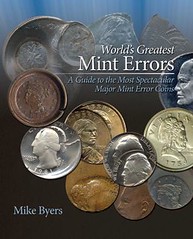 Jessica Mullenfeld of Zyrus Press publishing kindly sent me an electronic preview of one of their new books, World's Greatest Mint Errors by Mike Byers.
Jessica Mullenfeld of Zyrus Press publishing kindly sent me an electronic preview of one of their new books, World's Greatest Mint Errors by Mike Byers.In his Preface, the author writes:
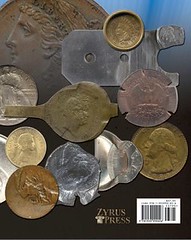 Since then, the mint error market has witnessed an explosion in collector interest. Today, there are hundreds of dealers, investors and collectors who are purchasing major mint errors far in excess of $7,750. Much has changed since 1975, and in large part, the driving motivation behind this book was to assemble in one place the mint errors that best represent the culmination and maturity of mint error coinage as a fundamental segment of the overall numismatic market.
Since then, the mint error market has witnessed an explosion in collector interest. Today, there are hundreds of dealers, investors and collectors who are purchasing major mint errors far in excess of $7,750. Much has changed since 1975, and in large part, the driving motivation behind this book was to assemble in one place the mint errors that best represent the culmination and maturity of mint error coinage as a fundamental segment of the overall numismatic market. I didn't recall there being any error coins in the John A. Beck collection, so I reached for my copy of Beck Part I, the January 1975 sale by Abner Kreisberg's "Quality Sales" corporation. And there it was - lot 609, plated. "Formerly in the collections of the famous St. Louis coin dealer B.G. Johnson and in the Col. Green collection... We know there are supposedly three other Cents struck in gold but none have been offered for many years.
From the Introduction
Many coins found within these pages are so unique that they have eluded widespread exposure in numismatic circles.
The Byers book is first and foremost a picture book, but what pictures! These are indeed spectacular error coins, all wonderfully photographed. Numismatic information is not forgotten, though - each chapter has a brief but accurate description of how each type of error is created. Each photographed coin is accompanied by a paragraph of information.
The word "World" in the book's title is a bit of a stretch. As made obvious by the cover photos, the overwhelming majority of the coins pictured are U.S. Mint products.
We recently discussed brockages (and have more in this issue). The topic is covered in Chapter 3. Other interesting chapters include Counterbrockages and Die Adjustment Strikes. Below are examples of chapter headings and individual coin listings.
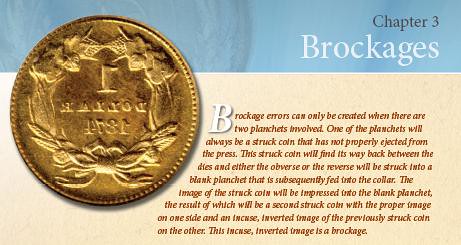
Each chapter includes a useful table listing market values for typical examples of the given error in various grades. Although the book is light on text, it provides a fine overview of the subject and I suspect it will be responsible for the creation of some new error collectors.
My main misgiving about the book is the inclusion in many of the photo groupings a picture of the coin in a third-party grading slab. What's up with that? I don't get it - the coin is already pictured and the slab is just a distraction, giving the book the feel of a dealer fixed price list. I'm not an anti-slab snob, but I don't see that these images add anything to the book.

The coin images look great on my computer screen, but I'll be curious to see how actually they look in print. As we've seen with other recently published coin books, the quality of the actual printed images can vary a great deal.
In summary, I enjoyed Byers' book and think both casual and advanced numismatists will enjoy it and learn a few things about errors and the minting process.
TWO NEW BOOKS: AUGUSTUS SAINT-GAUDENS AND MATTHEW BOULTON
Stephen Searle writes:1) Augustus Saint-Gaudens in The Metropolitan Museum of Art (Paperback) ISBN 978-0300151886.
2) Matthew Boulton: Selling What All the World Desires (Hardcover) ISBN 978-0300143584.
Amazon says the Boulton book will be published July 28. From the web site:
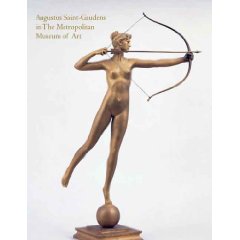 This book recounts the engaging story of a French-Irish immigrant who became the greatest American sculptor of his day. During his lifetime Saint-Gaudens (1848–1907) both contributed to exhibitions at the Metropolitan Museum and served as an advisor to its staff.
This book recounts the engaging story of a French-Irish immigrant who became the greatest American sculptor of his day. During his lifetime Saint-Gaudens (1848–1907) both contributed to exhibitions at the Metropolitan Museum and served as an advisor to its staff. After his death the Museum continued steadily to acquire his sculptures. Today it owns 45 of the sculptor’s works, ranging from delicate cameos and medals to innovative painterly bas-reliefs to stirring statuettes and portrait busts after Civil War monuments for East Coast cities.
Thayer Tolles appraises Saint-Gaudens’s groundbreaking position in the history of late 19th-century American sculpture and the Aesthetic Movement, and she also addresses his role in advancing American art on the international stage.
Amazon says the Boulton book will be published June 16. From the web site:
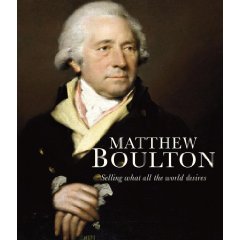 Matthew Boulton was an 18th-century designer, inventor, and industrialist, a consummate businessman, and co-founder of the influential Lunar Society. Now, on the bicentenary of his death, this book surveys his life and extraordinarily varied achievements. The book explains how Boulton, a Birmingham ‘toy’-maker producing buttons, buckles, and silverware, went into business with James Watt and exported Boulton & Watt steam engines all over the world. Meanwhile his magnificent ormolu ornaments decorated aristocratic drawing rooms, and his determination to discourage counterfeiters led to a contract to manufacture British coinage and coins of other countries at his mint.
Matthew Boulton was an 18th-century designer, inventor, and industrialist, a consummate businessman, and co-founder of the influential Lunar Society. Now, on the bicentenary of his death, this book surveys his life and extraordinarily varied achievements. The book explains how Boulton, a Birmingham ‘toy’-maker producing buttons, buckles, and silverware, went into business with James Watt and exported Boulton & Watt steam engines all over the world. Meanwhile his magnificent ormolu ornaments decorated aristocratic drawing rooms, and his determination to discourage counterfeiters led to a contract to manufacture British coinage and coins of other countries at his mint. Boulton was leader of the campaign to establish the Birmingham Assay Office (still the busiest in the country), and also at the heart of the Lunar Society, a group of prominent industrialists, natural philosophers, and intellectuals interested in scientific and social change.
Known to Ben Franklin, Thomas Jefferson, Erasmus Darwin, Josiah Wedgwood, and many others, Boulton was a fascinating man, Britain’s leading Enlightenment entrepreneur.
BOOK REVIEW: COLLECTING ANCIENT GREEK COINS BY PAUL RYNEARSON
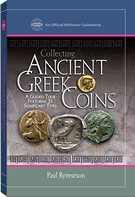 I'd like to put in a good word for a recent Whitman Guidebook that I finally had a chance to read through - Paul Rynearson's Collecting Ancient Greek Coins - A Guided Tour Featuring 25 Significant Types. Published earlier this year, the 255-page book is a very thorough and enjoyable read, and the illustrations are beautiful.
I'd like to put in a good word for a recent Whitman Guidebook that I finally had a chance to read through - Paul Rynearson's Collecting Ancient Greek Coins - A Guided Tour Featuring 25 Significant Types. Published earlier this year, the 255-page book is a very thorough and enjoyable read, and the illustrations are beautiful.I found it to be an excellent down-to-earth overview of a complex and often daunting field. Part I consists of five chapters on the historical and artistic background of the coins, basic numismatic principles, approaches to collecting and advancing as a collector. Part II is a group of 25 short chapters explaining various significant ancient Greek coin types. I found this organization made the topics very approachable and "digestible".
And yes, numismatic bibliophiles, the author devotes a number of pages to references and recommendations for books on Greek coinage. Rynearson writes:
Earlier in this issue I reviewed the Mike Byers book on error coins, and in a previous issue I reviewed Dave Bowers' new Colonial coin encyclopedia. Those two books are at opposite ends of a publishing continuum. The Byers book is loaded with gorgeous photographs and light on text; the Bowers book is heavier on text even though it also has a great number of photographs. Each book has its own niche.
Reading the Rynearson book I was struck with the thought that it strikes a perfect balance between these extremes. In every respect I kept coming back to the word "balanced". It's not too heavy and not too light. Like Goldilocks, I thought Rynearson's book was "just right". In summary, I have to say it's one of the best written and presented numismatic books I've ever read.
BOOK REVIEW: A GUIDE BOOK OF PEACE DOLLARS BY ROGER BURDETTE
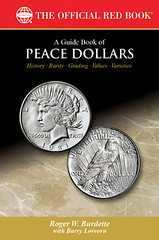 The Whitman Official Red Book Guide to Peace Dollars by Roger W. Burdette with Barry Lovvorn is an excellent full color 288 page soft cover book covering all aspects of U. S. Peace Dollars. It is the 13th entry in Whitman’s Bowers Series on numismatic references. It starts with some history on the silver purchases by the US government. Detailed information about the design and the competition is given extensive information about the high relief, as well as medium and low relief of the 1921 and 1922 dollars. Much of this information we have not read before.
The Whitman Official Red Book Guide to Peace Dollars by Roger W. Burdette with Barry Lovvorn is an excellent full color 288 page soft cover book covering all aspects of U. S. Peace Dollars. It is the 13th entry in Whitman’s Bowers Series on numismatic references. It starts with some history on the silver purchases by the US government. Detailed information about the design and the competition is given extensive information about the high relief, as well as medium and low relief of the 1921 and 1922 dollars. Much of this information we have not read before.The story of the lost 1964 Peace dollar is told along with the reasons and actions of all involved. Proofs, patterns, trial pieces, errors, misstrikes, countermarks, die varieties and famous collections are also covered extensively along with proof coin diagnostics.
The last chapter, chapter nine, covers all varieties by date and mint. Each date and mint variety has values by grade and gives certified populations. Varieties are given by VAM with pictures and diagnostics as well as values by grade. A separate paragraph with collecting advice is given by date and mint.
This book will come in handy when we review our complete Uncirculated Peace Dollar set we purchased in the early 1950s. At that time information on varieties, rarity and other background was not available.
We would highly recommend this Peace Dollar book to beginning and advanced collectors, because of all the information arranged in such an easy to use format. This book can be obtained for $19.95 from Whitman Publishing, LLC, 3103 Clairmont Road, Suite B, Atlanta, Georgia 30329 or call (800) 546-2995 or visit www.info@whitmanbooks.com
THE BOOK BAZARRE
WHITMAN'S DENNIS TUCKER'S REPORT ON THE MARCH 2009 BALTIMORE SHOW
- the 2010 edition of the Red Book (which debuted at the show; in particular, people were buzzing about the new 8.5 x 11 Large Print Edition)
- QDB's Whitman Encyclopedia of Colonial and Early American Coins, which "everyone" was talking about on the bourse, and which saw steady flight from our shelves
- Fred Reed's Abraham Lincoln: The Image of His Greatness. I haven't heard a single complaint; in fact, people are raving about this one. We actually sold out the inventory that we brought to the show! It's clear from talking to collectors and others that this book has great crossover potential, to jump beyond the antiques/collectibles niche (where most numismatic books reside) and into the awareness of general-history and American history buffs, students of the Civil War, and other "mainstream" audiences.
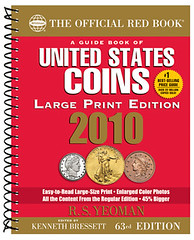
For me it was a fun show; I spoke with several potential authors about some interesting possibilities for future books, and caught up with current Whitman authors, including about 60 Red Book contributors.
NUMISMATIC SOCIETY OF AUCKLAND CELEBRATES 50TH ANNIVERSARY
The Coin and Banknote Fair will be held at the Kingsgate Hotel, 92-102 Gladstone Road, Parnell, Auckland, between 10.00am and 4.30pm, and admission is free.
The Society, which has a monthly magazine, MINTMARK, has always been a keen publisher, and there will be a number of copies of four of its latest works available for purchase on the day, while stocks last:
- Auckland Tradesmen's Tokens by Brian Bolton, $8, (photo illustrations)
- The Millennium Series (to mark the Millennium), $5, (colour photo illus.)
- The Duodecimal Coinage of New Zealand 1933-1965, $5, (line illustrations)
- Teutenberg - A Master Engraver and His Works, $35, (photo illustrations)
In the afternoon four presentations will be given:
- 2.00pm: Graeme Brown, of the Tauranga Numismatic Society, on "New Zealand Tokens".
- 2.30pm: Paul Etheredge, of the Waikato Numismatic Society, on "Athena, Bellerophon, Pegasos, The Chimera and the Medusa".
- 3.00pm: John Cresswell, of the Numismatic Society of Auckland, on "The First to Enlist".
- 3.45pm: Alistair Robb, of the Royal Numismatic Society of New Zealand, on "Error New Zealand Banknotes".
To mark this notable event the Society has had a medallion struck, using a die from its Teutenberg Archive. The original was made in 1897 to mark a Military Tattoo held in Auckland to celebrate Queen Victoria's Diamond Jubilee, and it has Queen Victoria's head as part of the obverse. The reverse carries the Society's name and the dates 1959-2009. The medal measures 40mm x 28mm.
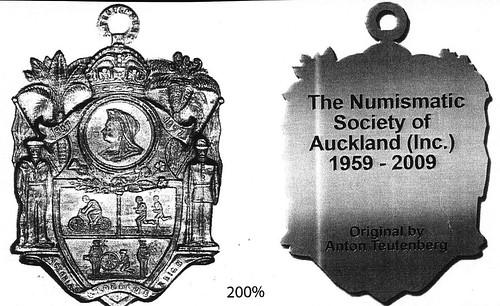
Medals must be ordered from the Society by Friday 17 April:
9ct Gold NZ$795.00
Sterling Silver NZ$49.50
Copper NZ$19.50
Delivery in NZ $6, overseas $10. Or they can be picked up on the day.
Each medal will be protected in a plastic envelope with a full explanatory pamphlet describing the four known specimens from 1897, and the present mintage figures. Anyone wishing to order a medal MUST do so before 17 April, 2009. Please write to the Society at P O Box 818, Auckland 1140, enclosing your full remittance.
FRACTIONAL CURRENCY RESEARCHER VISITS THE NATIONAL ARCHIVES
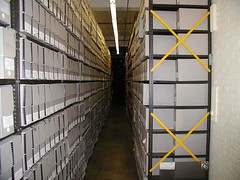 During a recent visit to the Philadelphia area on the way to see the inauguration of Barack Obama, I had a chance to visit the National Archives for 2 days. I am working on a book on Trimes, fractional currency of the round metal type. The Archives in Philadelphia is officially known as the National Archives Records Administration (NARA) Mid-Atlantic Region facility.
During a recent visit to the Philadelphia area on the way to see the inauguration of Barack Obama, I had a chance to visit the National Archives for 2 days. I am working on a book on Trimes, fractional currency of the round metal type. The Archives in Philadelphia is officially known as the National Archives Records Administration (NARA) Mid-Atlantic Region facility. The archives are located in the Robert Dix Federal Building downtown. To use the Archives, you must have a researcher’s card which is easy to get after filling out some paperwork. The documents are stored in the basement area under the main floor.
They have hundreds of thousands of documents from the U.S. Mint in Philadelphia. Although the public is not allowed in the storage area, the archivist supplied the enclosed picture.
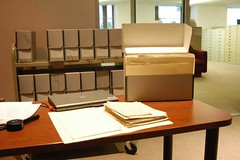 Most of the documents that I have been researching are hand written letters, which can lead to sore eyes from the many hours deciphering the handwriting! Some of the documents are easy to read, others not so much. Some are written on fine linen and cotton paper almost as fresh as the day it was made, others are tissue paper thin, brown and fragile. On some the ink is still bold and bright, others are faded and all but illegible. Some are bound in books, and others are folded in the original envelope.
Most of the documents that I have been researching are hand written letters, which can lead to sore eyes from the many hours deciphering the handwriting! Some of the documents are easy to read, others not so much. Some are written on fine linen and cotton paper almost as fresh as the day it was made, others are tissue paper thin, brown and fragile. On some the ink is still bold and bright, others are faded and all but illegible. Some are bound in books, and others are folded in the original envelope.I found several documents signed by Spinner. As a Fractional currency collector, I found these interesting. With his bold signature some of these were easy to spot. The first document found was one that I thought would most interest the members of FCCB. It is dated November 15, 1867 and is a partly written by hand.
Apparently the Director of the Mint H.R. Linderman made a request for a Fractional Shield for use in the Mint. This letter is in response to that request and states:
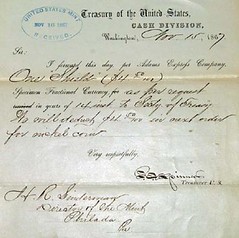

Let’s see, only $4.50 for a shield, I’ll take about a dozen! With a current value of several thousand dollars each, they have gone up a little in value!
MOVING SALE
Numismatic literature for sale by collector
9,000 numismatic auction catalogs
1,000 numismatic books
Hundreds of different numismatic journals
Will provide very attractive pricing for sales of large lots.
Email Chris Hoelzle at choelzle@cox.net for lists.
DICK JOHNSON ON DOCUMENTARY FILMS OF SIDNEY OHIO, COIN WORLD'S HOME
Two brothers, Bill Ross IV, and his sibling Turner, shot the 91-minute film in the autumn of 2007. Variety author Joe Leydon viewed the film on DVD and relates "Townspeople appear at gatherings -- a country fair, high school football games -- and in their homes, only occasionally addressing the camera." There is a story line of sort, of a young man's arrest and trial "much to his mom's dismay." Leydon's critique was positive, ending with "a polished docu that boasts ineffably beautiful HD lensing."
It reminds me of another Sidney Ohio documentary, filmed 49 years ago. A few months after Coin World was inaugurated a film crew came into the building shooting away. Coin World's first office at the time was at the head of tall stairway on the second floor of the Amos Press building. The editorial office for the Sidney Daily News was across the hall from that of Coin World's.
This event, of course, predated computers. Any view of a news room at the time shows the inhabitants doing one of two things (or occasionally both at once): talking on the phone or typing on an aged Remington typewriter. The 1960 Sidney film takes the viewer into the Daily newsroom.
Audio: Here is city editor... type, type, type. Here is the court reporter ... type, type, type. Here is the obituary writer ... type, type, type. Here is the editor working on today's editorial ... type, type, type.
The film crew crossed the hall to Coin World's office and shot 30-year old Dick Johnson at his desk. After an off-camera explanation what Coin World was the next scenario was Dick at work ... type, type, type.
With the 50-year anniversary of Coin World next year we wonder if some enterprising CW staffer can dredge up that old film. I would like to view that again to wonder if my typing style has improved in five decades ... type, type, type.
It is only two paragraphs, but you might want to view the Variety article: 45365 (www.variety.com/review/VE1117939996.html?categoryid=31&cs=1)
MORE ON COIN AND MEDAL LEGEND ABBREVIATIONS
LEGENDEN – LEXICON
DES
MITTELALTERS UND DER NEUZEIT
VON
WILHELM RENTZMANN
ERSTER – THEIL
ALPHABETISCH – CHRONOLOGIISCHE TABELLEN DER MUNZHERREN
VERZEICHNISS DER AUF MUNZEN VORKEMMEN DEN HEILIGEN
This was originally published (in two parts) in 1865 and our copy was reprinted (in one part) in 1977. The first part is 192 pages, the second is 248 pages, followed by an additional 46 pages. From what I can figure, this includes the legends and abbreviations found on coins and the full text of those legends.
The first problem for me is that the text is in German. A second problem for users is that it was published in 1865 so modern coins are not included. The third problem is that this does not include the legends on medals.
An example of the abbreviated legend is D.G.S.D.E.S.A.B.G.O.T.A.E.P.G.E.I.M.N.D. L.E.B.S.R.I.E.C.A.R.A.M.M.T.D.L.P.E.G.G.B.A.” This is followed by about 42 words in German. Many of these legends include extensive titles of the rulers who issued the coins.
I do not suggest this answers the need of numismatists today. I will suggest that it might be a model for a researcher who wants to compile something similar for English readers. I like the idea of including such information on a website but the task is huge.
In the back of British Historical Medals 1760-1960 by Laurence Brown is an extensive list of medal legends in English. These entries are then linked back to the description of these medals. Such a reference is needed for all medals in all languages. While it would be good to provide a translation for foreign language legends, that might be little help if it were not also possible to identify the country of origin.
In some eras there are more different medals produced than different coins. I suspect that legends on medals often make creative use of language. There are words that appear to be Latin but not part of the traditional language. I believe the legends on most American medals are self-explanatory.
I find it curious that the work by Rentzmann was reprinted but not updated. Recent discussion in the E-Sylum shows the need for such a publication.
THE BOOK BAZARRE
QUERY: COINS OR MEDALS COMMEMORATING SOLAR ECLIPSES
MORE ON KADMAN'S CORPUS OF THE COINS OF THE JEWISH WAR
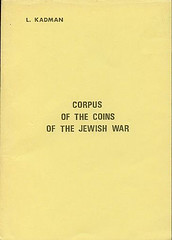
Bill adds: Here's how George Kolbe described it in a 1992 catalog:
MORE ON AUSTRIAN NOTGELD
Last week Dave Kellogg asked:At my request Dave provided images of some of his notes. He adds:
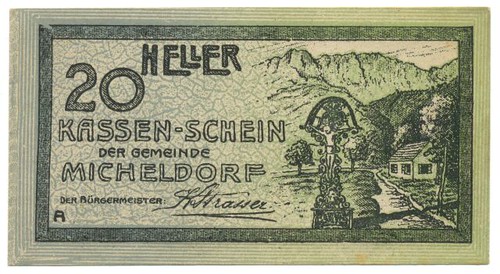
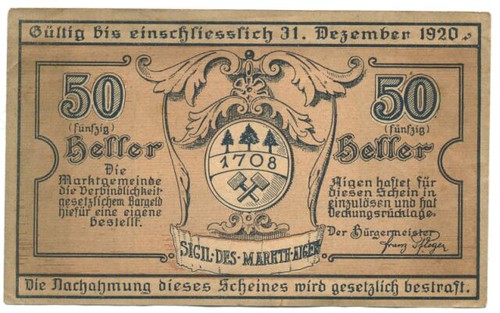
Loren Gatch writes:
TIMOTHY GRAT OF THE MOFFATT MINT ON BROCKAGES
The description Mike gave indeed covers the first steps in the creation of this error, including in my opinion its "helped" nature. However, this piece is one more step in the progression described.
Simply put, this piece is the brockage of the coining error Mike describes. This is evidenced by the lettering being in reverse... I would call this a "Brockage of a Double Struck Retained Indent"
I have attached an image to show the progression of the pictured coin...including the "gorgeous brockage on an undersized planchet that would fit with Bill's coin as snuggly as two pieces of a puzzle!" ...as Mike put it.
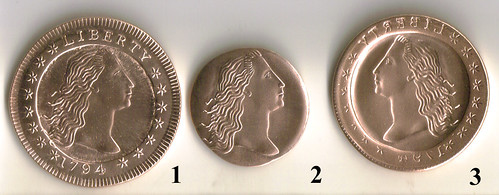
- Step 1 - Coin is struck and stays in coining chamber for whatever reason.
- Step 2 - Smaller planchet inserted onto struck coin and struck again
- Step 3 (Bill's coin) - Third, full size planchet, inserted onto double struck retained indent, and struck again!
USER REVIEW: NEOCOLLECT.COM
The website is fast, intuitive and easy to use. It allows you to include whatever information you want, and allows you to keep part of that information private (for instance, price paid), or to keep some coins private and other public. A very interesting feature is that you can import data from an MS-Excel spreadsheet, although it brings additional work in preparing such a sheet to fit more or less the way it asks data.
There are of course some flaws, but they are all minor and I suppose easy to solve when it proves to be worth doing (for instance the tabs for Reference Numbers, not so intuitive to use, or, more as a suggestion, the website could provide a model of Excel sheet to facilitate work).
The overall design is clean, light and well executed, and very pleasant. The overall appearance is sober and as far as I could observe, the pictures of several collections displayed are of very good quality. My concern is how the quality standard will be kept when more and more people start to upload items; perhaps it will have to count on a moderator or so.
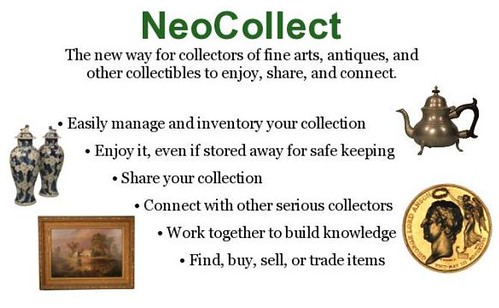
Among other things I'd suggest to provide an option to export users' data into an Excel sheet as a way to have all information in a backup; also to allow an option to make several items public at once, instead of doing one at a time.
Finally, my last concern is how likely this will last for long, I mean on what it depends to last, since it takes quite a bit of time to upload big collections and it is natural people would not like to lose all this time if the site won't last for any reason - I'd like to know how other readers feel about this.
Just to give you a taste, I invite you to see part of my collections, Brazilian 640 reis, Mughal coins and Durrani coins. I hope you appreciate my work.
http://www.neocollect.com/coll/116/
http://www.neocollect.com/coll/90/
http://www.neocollect.com/coll/111/
MORE ON 1931 THE BAYONNE BRIDGE DEDICATION MEDAL
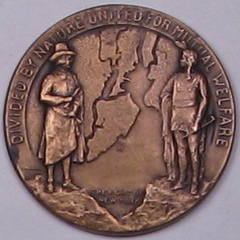 Dick Johnson asked me to comment on the high price this 32.2mm medal which sold for $174.15 on Ebay and mentioned in The E-Sylum last week. This medal is by Julio Kilenyi and Dick knew of my interest in Kilenyi medals. My initial reaction was “WOW!”
Dick Johnson asked me to comment on the high price this 32.2mm medal which sold for $174.15 on Ebay and mentioned in The E-Sylum last week. This medal is by Julio Kilenyi and Dick knew of my interest in Kilenyi medals. My initial reaction was “WOW!”My research on this medal indicates that it is relatively scarce by medallic standards. It is one of three versions struck for the dedication. There is a 76.3mm table medal and a 31.5mm fob hung from a blue ribbon and probably worn as a hanging badge at the ceremony. The medals were struck by Whitehead & Hoag and issued by the Port of New York Authority. All of the W&H records were destroyed in 1955 and the Port Authority records went up in 9/11. I have not found any other source for mintage figures. So empirical evidence must suffice.
Auction Records: Ebay; since 2002 the hanging badge has sold 14 times and made an average $36 each. The table medal has come up 5 times and made $67 on average. The small round piece had come up only twice prior to 3/23/09 and averaged $25.70 a sale.
Auction Records: Johnson & Jensen; during the history of this company, the table medal was auctioned off 5 times and the hanging badge once.
Historical Perspective: In 1931, the Port Authority opened two major bridges, the George Washington Bridge on Oct. 24th and the Bayonne Bridge on Nov. 14th. The GWB Dedication made a big medallic splash with 2 gold medals, silver medals, bronze medals in 2 sizes, a hanging badge and a small round medal.
The opening of the GWB was a major political event. The Governor of NY, Franklin Delano Roosevelt, a man with serious Presidential aspirations, was one of the major participants in the ceremonies. Three weeks later, the major state election now past, the Port Authority, I am sure, ordered only enough medals to service the needs of the Bayonne Bridge Dedication on the day. Hence relatively few of the small round medals were probably produced.
Name Change: On Oct. 31st, The Port Authority changed the name of the bridge from the Kill van Kull Bridge to the Bayonne Bridge. This added a time constraint that would also have mitigated against a larger number of medals than absolutely necessary being produced before the opening two weeks later.
Comparison of Ebay Sales: Numbers for both medals:
GWB Fob-14; Round-9; Table-21
Bayonne Fob-14; Round-3; Table-5
The fact that a medal is scarce does not necessarily affect its price in the market. This market is usually quite thin and in the past Port Authority medals have been little sought after. Recently there has been a marked increase in interest in New York City medals. On 3/31 a silver GWB Dedication medal went for $527 on Ebay. In the case of this Bayonne Bridge medal, there were two highly motivated buyers and, I think, a very surprised seller.
To read the previous E-Sylum article, see: 1931 BAYONNE BRIDGE DEDICATION MEDAL (www.coinbooks.org/esylum_v12n13a16.html)
THOUGHTS ON ELECTONIC PUBLICATION OF NUMISMATIC INFORMATION
The problems are varied, ranging from The E-Sylum depending on a variety "free" resources that aren't under any long-term requirements to keep copies available (the issue I got today already has one photo about which Flickr has only "THIS PHOTO IS CURRENTLY UNAVAILABLE" to say, and that type of "bitrot" doesn't improve with time), to proprietary formats that deliberately make it hard for readers to save a complete issue.
Yes, your paper copy of Coin World will go downhill quickly if you leave it in the sun and there are some books printed on cheap paper which are turning into dust, but even with those the survival rate in the hands of anybody with the slightest motivation to maintain their library will exceed what happens when Amos Publishing decides, say in 5 years, that a new proprietary format and online reader are the way to go and after a 3-month grace period they're going to discard the old archives. Even if you do find somebody who jumped through all the hoops to somehow save a decent replica, you'll probably find that there are legal issues with gaining access to it.
There are certainly efforts to address this effect, see for example http://en.wikipedia.org/wiki/PDF/A about PDF/A, a subset of PDF with a tight definition in an ISO standard, specifically designed to be supported for the very long term.
Unfortunately, I doubt these efforts are of much concern to those who must worry about this week's advertising revenue, how much copy they have for next week's issue, and what that worrisome trend in subscriber count really means. Whether your issues are still available in 30 years has, I suspect, very little commercial value, but possibly immense value to the historian.
ENCYCLOPEDIA BRITTANICA OUTLIVES COMPETITOR ENCARTA
As Blown to Bits recounts,
Tuesday Microsoft announced that it’s pulling the plug on both the CD-ROM and the online version of Encarta. The crowd-sourced Wikipedia is credited with its demise.
At one level, Clay Christensen has yet another example for his disruptive innovation commoditization story — in which a commoditized technology itself gets commoditized. We saw this with minicomputers wiped out by PCs and someday PCs wiped out by mobile phones.
But I also find it interesting that Britannica (at least in its online version) will outlive Encarta. While Britannica is in its own life-and-death struggle with Wikipedia, it appears (at least in the short run) that its emphasis on quality is being recognized.
This means we'll at least have Brittanica (paid), the Columbia Encyclopedia (available free on Dictionary.com) and Wikipedia. Given both Wikipedia’s severe limitations as well as the inherent risk of a single source of information for the world, as a member of a free society I hope the market doesn’t collapse any further.
To read the complete article, see: Britannica Has the Last Laugh as Microsoft Cancels Online Encyclopedia (seekingalpha.com/article/128876-britannica-has-the
-last-laugh-as-microsoft-cancels-online-encyclopedia?source=email)
CRUSADER COINAGE SYMPOSIUM AT PRINCETON UNIVERSITY
Speakers will include Julian Baker (Ashmolean Museum, Oxford), Pagona Papadopoulou (Princeton University), Scott Redford (Koç University, Istanbul), Robert Kool (Israel Department of Antiquities, Jerusalem) and James Todesca (Armstrong Atlantic University, Savannah). Respondents will be Alan Stahl (Princeton University) and Oleg Grabar (Institute for Advanced Study).
An exhibit featuring coins from Princeton's newly-acquired Latin Orient Collection will open at Firestone Library that afternoon and run through May 12.
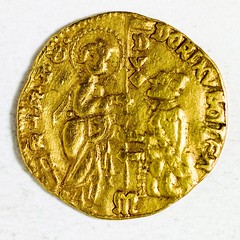
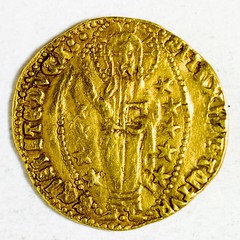
An imitation ducat minted at Mytilene on the island of Lebos by Dorino Gattilusio, in the period 1400-1449.
Details on the symposium are available at http://www.princeton.edu/~hellenic/ImitationAppropriation.html. For more information, contact Alan Stahl, Curator of Numismatics, Princeton University, at astahl@princeton.edu.
LECTURE: READING RENAISSANCE PORTRAITS: CLUES FROM MEDALS
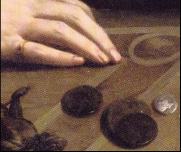 On Tuesday, April 21, 2009 the ANS will hold the inaugural Mark M. Salton Memorial Lecture at their new headquarters. Mr. Syson, Curator at the National Gallery in London, will give a lecture entitled “Reading Renaissance Portraits: Clues from Medals.”
On Tuesday, April 21, 2009 the ANS will hold the inaugural Mark M. Salton Memorial Lecture at their new headquarters. Mr. Syson, Curator at the National Gallery in London, will give a lecture entitled “Reading Renaissance Portraits: Clues from Medals.” Luke Syson studied art history at the Courtauld Institute and joined the British Museum as curator of medals in 1991. During his time there, he co-edited (with Nicholas Mann) the volume The Image of the Individual: Portraits in the Renaissance (1998) and cowrote (with Dora Thornton) 'Objects of Virtue: Art in Renaissance Italy (2001).
He left the British Museum in 2002 while working on the Enlightenment Gallery there, and briefly joined the Victoria and Albert Museum as Senior Curator, Medieval and Renaissance Galleries. In 2003, he joined the National Gallery as Curator, Italian Painting, 1460-1500.
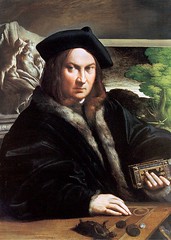 Parmigianino (1503-1540)
Parmigianino (1503-1540) Portrait of a Collector, about 1523
oil on panel, 89.5 x 63,8 cm
The National Gallery, London (NG 6441)
To read my earlier London Diary, see: WAYNE'S LONDON DIARY 27 MAY 2007 (www.coinbooks.org/esylum_v10n21a12.html)
OLD SAN FRANCISCO MINT BUILDING OPENS FOR ART SHOW
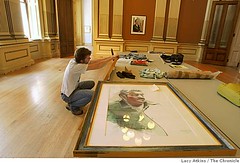 The public will get a rare chance to take a look inside San Francisco's venerable Old U.S. Mint this weekend, when the San Francisco Museum and Historical Society hosts an art show called "Faces of the City" from today to Tuesday.
The public will get a rare chance to take a look inside San Francisco's venerable Old U.S. Mint this weekend, when the San Francisco Museum and Historical Society hosts an art show called "Faces of the City" from today to Tuesday.The show, by artist Elaine Badgley Arnoux, includes portraits of 140 San Franciscans, from senators, mayors and big time civic leaders to Muni operators and garbage collectors.
In the Mint's grand corner office, complete with gilded chandeliers and an ornate fireplace, House Speaker Nancy Pelosi's portrait shares space with Frank Comelia, a commercial fisherman, and Carl Payne, a police officer who was once the city's premier cable car gripman.
The Old Mint has always fascinated her. "I wanted to get into the Old Mint before I die, '' she said. Actually, the Old Mint, which has graced the corner of Fifth and Mission streets for 135 years, is the star of its own show. It was built to handle the incredible silver output from the Comstock lode in Virginia City, Nev. and for many years was the largest federal building west of the Mississippi.
Later its vaults held up to one-third of the entire gold supply of the U.S. treasury - worth $6 billion in today's currency.
The building, which is built of granite and sandstone, was the largest structure to withstand the 1906 earthquake and fire. It continued as a mint until 1937, stood empty for some years, reopened as a coin museum, and closed again in 1994.
The federal government gave the Old Mint to the city of San Francisco for $1 and the city in turn handed it over to the San Francisco Museum and Historical Society, which plans to turn it into a museum of San Francisco history.
In the meantime, the Old Mint, with its spooky basement vaults lined with steel, its grand Victorian offices with 20-foot high ceilings, walls three feet thick, fireplaces and gilt chandeliers, has been closed to the public.
The Old Mint is open only for private parties; the last time the public was allowed inside was for an art show five years ago.
The historical society says it will cost $95 million to make the building seismically safe and upgrade it to a museum.
So far, about a third of the money has been raised though federal grants and tax write-offs. The rest - about $60 million - is needed to make the Old Mint into a museum and visitor center, which historical society Executive Director Erik Christoffersen calls "a window into the men and women who made this city and this region."
If you go: The art show Faces of the City will be on display at the Old U.S. Mint from noon to 5 p.m. today through Tuesday. Admission is $10.
For information, call the San Francisco Museum and Historical Society at (415) 537-1105, ext. 100, or go to www.sfhistory.org.
To read the complete article, see: Art show opens S.F.'s Old U.S. Mint to public (www.sfgate.com/cgi-bin/article.cgi?f=/c/a/2009/04/02/BAKG16QCKN.DTL)
VIRGINIA'S RESOLUTION RECOGNIZING ERIC NEWMAN'S NUMISMATIC RESEARCH
 At the last meeting of Nummis Nova, my Northern Virginia numismatic social club, Tom Kays displayed an interesting piece of numismatic ephemera. It was a copy of a January 1992 resolution by the state of Virginia honoring author Eric P. Newman's research on Virginia colonial coinage.
At the last meeting of Nummis Nova, my Northern Virginia numismatic social club, Tom Kays displayed an interesting piece of numismatic ephemera. It was a copy of a January 1992 resolution by the state of Virginia honoring author Eric P. Newman's research on Virginia colonial coinage. Tom also sent a copy of the Summer 1992 ANS Newsletter with an article about the presentation. It notes that ANS member William Veach was instrumental in securing the resolution.
Tom also sent a copy of the Summer 1992 ANS Newsletter with an article about the presentation. It notes that ANS member William Veach was instrumental in securing the resolution.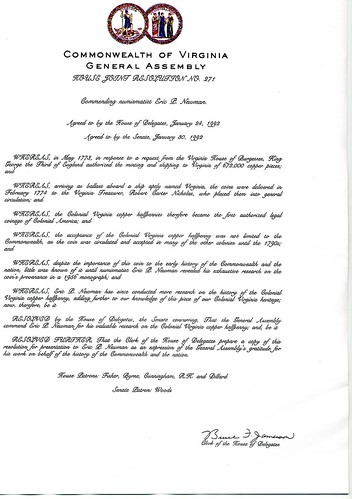
MALMESBURY ROMAN COIN HOARD DISPLAYED IN ATHELSTAN MUSEUM
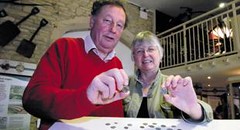 A hoard of Roman coins now on display in Malmesbury has perplexed staff at the Athelstan Museum.
A hoard of Roman coins now on display in Malmesbury has perplexed staff at the Athelstan Museum. The stash was discovered in a field in Milbourne two years ago and has now been cleaned up and given to the museum.
Chairman of the Friends of Athelstan Museum, Roger Griffin, is puzzled as to the purpose of the collection.
He said: “These coins aren’t the equivalent of £20 notes. They are quite small coins, like loose change really.
“They might have been the savings of a slave waiting for his release or possibly a child’s pocket money. They certainly were a poor person’s hoard.”
At first, 24 coins were found scattered over a small area and later a further 14 coins were found.
The coins, known as nummi, date from 305 to 325 AD but there are none in the seven years from 313 to 320.
Mr Griffin said: “We’re not sure why there is a gap, maybe the owner went away for seven years and then came back.
To read the complete article, see: Experts baffled by Malmesbury's Roman coins (http://www.gazetteandherald.co.uk/news/towns/
malmesburyheadlines/4198310.Experts_baffled_by_Malmesbury_s_Roman_coins/)
WELSH FOOTBALL FANS PELT REFEREE WITH COINS (AND NOT IN A GOOD WAY)
Mike Dean was cut above his right eye but continued to officiate the League Championship match between Cardiff and Swansea at Ninian Park after being treated. Police arrested a Cardiff supporter.
"It was an absolutely crazy thing to do," Cardiff manager Dave Jones said. "Throwing a coin could have easily taken someone's eye out. It could have hit one of our players, one of the Swansea players or the referee. Why do it?"
Police officers are studying CCTV to identify other fans who appeared to throw missiles onto the field.
To read the complete article, see: Ref's head cut by coin hurled by fan (sportsillustrated.cnn.com/2009/soccer/04/05/referee.coin.ap/index.html)
"GROCERY MONEY" WOMAN ARRESTED FOR STEALING GOLD COINS
Washington City police arrested Emily Cammack, 24, after she returned to the same Zions Bank branch and was recognized by an employee.
"She actually stole them from a family she was living with," Washington City Police Lt. Ed Kantor said Thursday. "She had befriended one of the family members over the Internet and moved here from out of state. They let her live with them at their home, she went through some property and discovered these coins."
Police said Cammack showed up at a Zions Bank in the St. George area on March 14 with the rare gold coins, seeking to exchange 14 of them for grocery money. She told the teller that Wal-Mart wouldn't accept the coins to buy groceries and sent her to the bank.
She left with about $280, but the coins are worth 50 times more than that.
Kantor said police began investigating just in case the coins were stolen.
"With a value like that, we wanted to make sure we didn't miss anything," he said.
Their case had gone nowhere until Cammack walked back into the same branch recently with the victim's daughter. A teller recognized her and called police.
The victim had no idea the coins were even missing until contacted by police when Cammack was arrested, Kantor said.
Cammack was booked into the Purgatory Jail on Wednesday on investigation of second-degree felony theft. She remains there in lieu of $10,000 bail.
To read the earlier E-Sylum article, see: WOMAN CASHES IN DOUBLE EAGLE GOLD COINS AT FACE VALUE FOR GROCERY MONEY (www.coinbooks.org/esylum_v12n13a21.html)
FEATURED WEB SITE: BULGARIAN PAPER MONEY
This week's Featured Web site is an online gallery of Bulgarian paper money.The Turkish lira was adopted as main unit of currency. It contained 7,216 drams of gold with hallmark 916,6. Every Turkish lira was equal to 5 Turkish silver coins (medzhidia) and every medzhidia was equal to 20 groshes.
In 1863 the Empire Ottoman Bank was established and it had the rights to issue banknote (kaimeta). But the first Turkish paper money failed, because the Bank was very far and the traveling to it was very expensive and dangerous. Despite the enormous gold holding of the Bank the exchange of banknote was practically impossible. The people didn't trust those "paper pieces", and didn't accept them as units of currency. During that period different kinds of silver coins went into circulation and the gold (pendaras) were used in the most important deals.

www.bg-papermoney.com/
